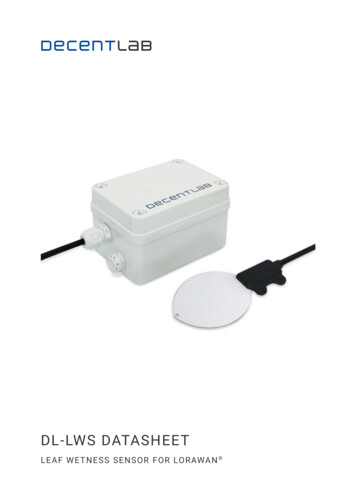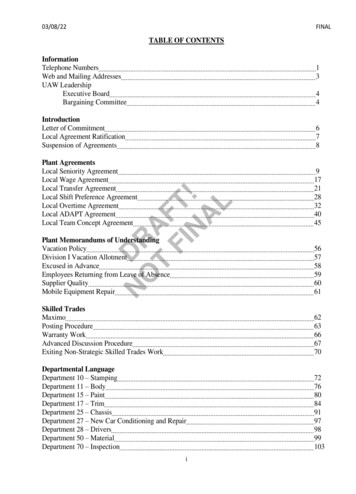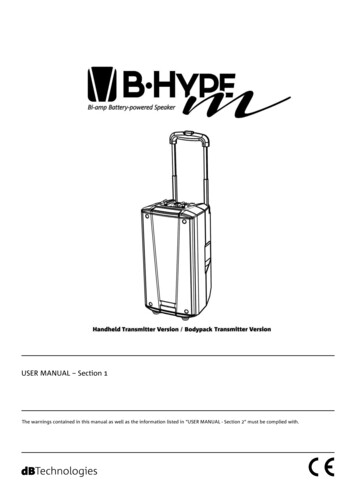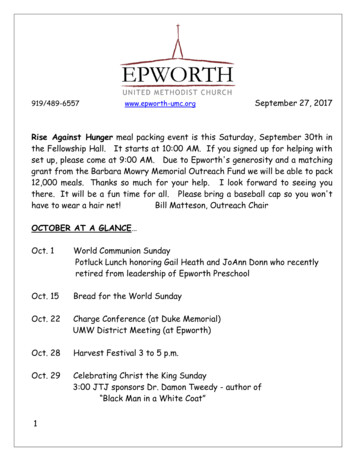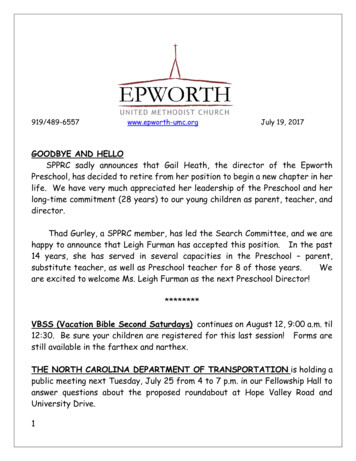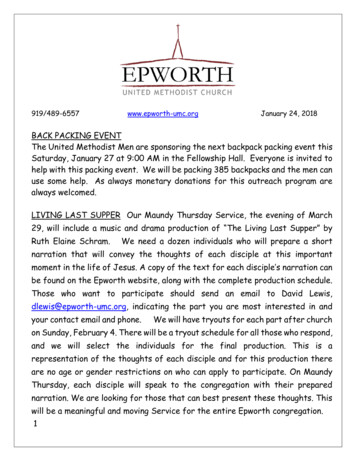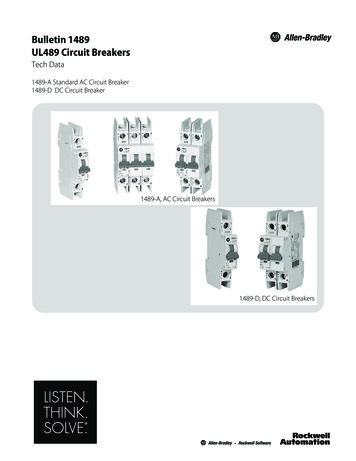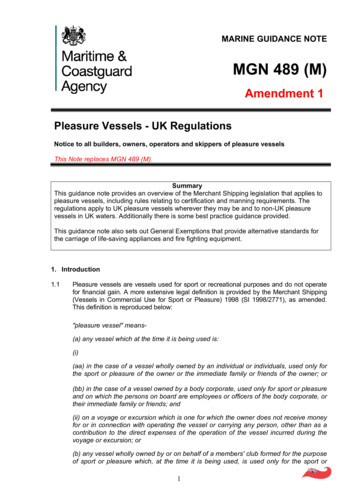
Transcription
Maritime and Coastguard Agency LogMARINE GUIDANCE NOTEMGN 489 (M)Amendment 1Pleasure Vessels - UK RegulationsNotice to all builders, owners, operators and skippers of pleasure vesselsThis Note replaces MGN 489 (M).Summary.This guidance note provides an overview of the Merchant Shipping legislation that applies topleasure vessels, including rules relating to certification and manning requirements. Theregulations apply to UK pleasure vessels wherever they may be and to non-UK pleasurevessels in UK waters. Additionally there is some best practice guidance provided.This guidance note also sets out General Exemptions that provide alternative standards forthe carriage of life-saving appliances and fire fighting equipment.1. Introduction1.1Pleasure vessels are vessels used for sport or recreational purposes and do not operatefor financial gain. A more extensive legal definition is provided by the Merchant Shipping(Vessels in Commercial Use for Sport or Pleasure) 1998 (SI 1998/2771), as amended.This definition is reproduced below:"pleasure vessel" means(a) any vessel which at the time it is being used is:(i)(aa) in the case of a vessel wholly owned by an individual or individuals, used only forthe sport or pleasure of the owner or the immediate family or friends of the owner; or(bb) in the case of a vessel owned by a body corporate, used only for sport or pleasureand on which the persons on board are employees or officers of the body corporate, ortheir immediate family or friends; and(ii) on a voyage or excursion which is one for which the owner does not receive moneyfor or in connection with operating the vessel or carrying any person, other than as acontribution to the direct expenses of the operation of the vessel incurred during thevoyage or excursion; or(b) any vessel wholly owned by or on behalf of a members' club formed for the purposeof sport or pleasure which, at the time it is being used, is used only for the sport or1
pleasure of members of that club or their immediate family, and for the use of whichany charges levied are paid into club funds and applied for the general use of the club;and(c) in the case of any vessel referred to in paragraphs (a) or (b) above no otherpayments are made by or on behalf of users of the vessel, other than by the owner.In this definition "immediate family" meansin relation to an individual, the spouse or civil partner of the individual, and a relative ofthe individual or the individual's spouse or civil partner; and "relative" means brother,sister, ancestor or lineal descendant;1.2This note provides advice and some detail on the legislation that applies to pleasurevessels. More specific information can be obtained by consulting the relevant legislationand guidance, available on the MCA website www.dft.gov.uk/mca or by contacting theMCA.1.3If more than 12 passengers1 are carried, irrespective of whether payment is made, thevessel is a “passenger ship” under UK Merchant Shipping regulations and needs to beappropriately surveyed and certificated. If more than 12 passengers are intended to becarried, the MCA must be contacted through the nearest MCA Marine Office2. The localMCA Marine Office will provide guidance on the procedures and standards to be followedfor a pleasure vessel intending to carry more than 12 passengers.1.4It is strongly recommended that these best practice guidelines are followed at all times, inaddition to complying with the regulations this Note provides information on: 12Get Trained – It is sensible to undertake some form of training; if you do gettrained you will be far less likely to be involved in a maritime incident. If you getinto difficulty you will also know how to get the right help quickly, reducing theimpact of your problem;Check the weather and tides – Always check the weather and tidal conditionsbefore you set out so that you can prepare accordingly. At sea changes in tidalstreams could make conditions worse, particularly if the wind and tide areagainst each other. Tidal heights may hide underwater hazards;Wear a lifejacket – a lifejacket that is properly serviced and maintained willsignificantly increase your survival chances if you fall overboard. It should be fittedwith a light, whistle and spray hood and if possible crotch straps to stop thelifejacket riding up over your head;Avoid alcohol – If you have been drinking alcohol, your judgement will beimpaired and you will be more likely to make mistakes, which at sea could belife threatening;Keep in touch – Tell someone responsible ashore where you are going and whattime you expect to return so they are able to let the Coastguard know if you aremissing; andA passenger is any person carried in a ship, except;a person employed or engaged in any capacity onboard the vessel and on the business of the vessel;a person on board the vessel either in pursuance of the obligation laid upon the master to carryshipwrecked, distressed or other persons, or by reason of any circumstance that neither the master northe owner could have prevented or forestalled; anda child of under one year of ageA list of the contact details for the MCA’s Marine Offices can be found ontact07/marineoffices.htm-2-
Wear the kill cord – if your boat is fitted with a kill cord, please ensure the driverwears it. If the driver ends up falling overboard, it may help save their life and thelives of others who may also be in the water.2Definitions2.1Unless stated otherwise the following definitions shall apply throughout this guidancenote.“length” is as defined in the Merchant Shipping (Tonnage) Regulations 1997 (SI1997/1510), which is:the greater distance of the following distances –(a) the distance between the fore side of the stem and the axis of the rudder stock; or(b) 96 per cent of the distance between the fore side of the stem and the aft side of thestern;the points and measurements being taken respectively at and along a waterline at 85per cent of the least moulded depth of the ship. In the case of a ship having a rake ofkeel the waterline shall be parallel to the designed waterline;"GT" means gross tonnage and a reference to gross tonnage (a) in relation to a ship having alternative gross tonnages under paragraph 13 ofSchedule 5 of the Merchant Shipping (Tonnage) Regulations 1982 (SI 1982/841)permitted to be used pursuant to regulation 12(1) of the Merchant Shipping (Tonnage)Regulations 1997 (SI 1997/1510) is a reference to the larger of these tonnages; and(b) in relation to a ship having its tonnage determined both under Part II and regulation12(2) of those 1997 Regulations is a reference to its gross tonnage as determinedunder regulation 12(2).3.Safety of Navigation for Pleasure Vessels3.1In section 3 of this note:"length" in relation to a registered ship3 means length defined in section 2.1 above andin relation to an unregistered ship means the length from the fore part of the stem tothe aft side of the head of the stern post or, if no stern post is fitted to take the rudder,to the fore side of the rudder stock at the point where the rudder passes out of the hull;3.23On 1 July 2002, The Merchant Shipping (Safety of Navigation) Regulations 2002 (SI2002/1473) came into force, which directly affect pleasure vessel users. TheseRegulations implement Chapter V (on Safety of Navigation) of the InternationalConvention for the Safety of Life at Sea, 1974, otherwise known as SOLAS Chapter V.Most of the SOLAS Convention applies to large commercial ships, but parts of ChapterV apply to small, privately owned pleasure craft. Further information on SOLASChapter V can be found at html.This provides information on the rules for the safety of navigation that apply to pleasurevessels of differing sizes.A registered ship means a ship registered on the register of British ships maintained for the UnitedKingdom under section 8 of the Merchant Shipping Act 1995.-3-
3.3The following requirements apply to all vessels, irrespective of size. If you are involvedin a boating accident and it is subsequently shown that you have not applied the basicprinciples outlined in this document, you may be breaking the law and could ultimatelyface prosecution.3.3.1Voyage Planning3.3.1.1 SOLAS Regulation V/34 (‘Safe Navigation and avoidance of dangerous situations’)concerns prior-planning for your boating trip, more commonly known as voyage orpassage planning. Voyage planning is basically common sense. As a pleasure vesseluser, you should particularly take into account the following points when planning aboating trip:3.3.2 Weather: before you go boating, check the weather forecast and get regularupdates if you are planning to be out for any length of time. Tides: check the tidal predictions for your trip and ensure that they fit with whatyou are planning to do. Limitations of the vessel: consider whether your vessel is up to the proposed tripand that you have sufficient safety equipment and stores with you. Crew: take into account the experience and physical ability of your crew. Crewssuffering from cold, tiredness and seasickness won’t be able to do their jobproperly and could result in an overburdened skipper. Navigational dangers: make sure you are familiar with any navigational dangersyou may encounter during your boating trip. This generally means checking an upto-date chart and a current pilot book or almanac. Contingency plan: always have a contingency plan in case something goeswrong. Before you go, consider places where you can take refuge shouldconditions deteriorate or if you suffer an incident or injury. Bear in mind that yourGPS set is vulnerable and could fail at the most inconvenient time. This might bedue to problems with electrical systems, jamming or interference with the signals ormeteorological activity. It is sensible and good practice to make sure you are notover-reliant on your GPS set and that you have sufficient skills and information(charts, almanac and pilot book) to navigate yourself to safety without it should itfail. Information ashore: make sure that someone ashore knows your plans andknows what to do should they become concerned for your wellbeing. The MCArecommends joining the Coastguard Voluntary Safety Identification Scheme(commonly known as CG66) which is free and easy to join. The scheme aims tohelp the Coastguard to help you quickly should you get into trouble while boating. Itcould save your life. Join CG66 online at ga-searchand rescue/cg66.htm .Radar Reflectors3.3.2.1 Many large ships rely on radar for navigation and for spotting other vessels in theirvicinity. So, whatever size your boat is, it is important to make sure that you can beseen by radar. SOLAS Regulation V/19 requires all small craft (less than 150GT) to fita radar reflector or other means, to enable detection by ships navigating by radar atboth 9 and 3 GHz ‘if practicable’. This means if it is possible to use a radar reflector on-4-
your boat then you should use one. You should fit the largest radar reflector in terms ofRadar Cross Section (RCS) that you can. Whatever length your boat is, the radarreflector should be fitted according to the manufacturer’s instructions, and as high aspossible to maximise its effectiveness.3.3.3Life-saving Signals3.3.3.1 SOLAS Regulation V/29 requires you to have access to an illustrated table of therecognised life-saving signals, so that you can communicate with the search andrescue services, or other vessels, if you get into trouble. You can get a free copy of thistable in a leaflet produced by the MCA, available at www.dft.gov.uk/mca, or you canfind it in various nautical publications. It is also available in Annex 2 of this document. Ifyour vessel is not suitable for carrying a copy of the table on board (because it is smallor very exposed), make sure you have studied the table before you go boating.3.3.4Assistance to Other Craft3.3.4.1 SOLAS Regulations V/31, V/32 and V/33 require you:to let the Coastguard and any other vessels in the vicinity know if you encounteranything that could cause a serious hazard to navigation, if it has not already beenreported. You can do this by calling the Coastguard on VHF, if you have a radioonboard, or by telephoning them at the earliest opportunity. The Coastguard will thenwarn other vessels in the area; andto respond to any distress signal that you see or hear and help anyone or any vessel indistress as best you can.3.3.5Misuse of Distress Signals3.3.5.1 SOLAS Regulation V/35 prohibits misuse of any distress signals. These are critical tosafety at sea and by misusing them you could put your or someone else’s life at risk.4.The International Regulations for Preventing Collisions at Sea (COLREGS)4.1With respect to navigation and collision avoidance, any person in charge of any vesselthat proceeds to sea, irrespective of size, is required to comply with the MerchantShipping (Distress Signals & Prevention of Collisions) Regulations 1996 (SI 1996/75).These UK regulations implement the International Regulations for the Prevention ofCollisions at Sea and it is of paramount importance that all persons in charge of vessels atsea comply with them. They are contained within the merchant shipping regulationswhich also set out the penalties for non-compliance. A breach of the regulations couldresult in a substantial fine or custodial sentence. Copies of the requirements can also beobtained from yacht chandlers or found in various other publications such as nauticalalmanacs.4.2The Regulations apply to all vessels upon the high seas and in all waters navigable byseagoing vessels and require that all vessels that proceed to sea are correctly providedwith, and exhibit, navigation lights, shapes and sound signalling devices consistent withthe vessels' length, type and circumstances. Navigation lights are required if the vessel islikely to operate at night or in poor visibility by day.-5-
4.3While special rules may be made by an appropriate authority for roadsteads, harbours,rivers, lakes or inland waterways connected with the high seas and navigable by seagoingvessels, such special rules shall conform as closely as possible to the COLREGS.4.4The COLREGS consist of the following sections:Part A – GeneralPart B – Steering and Sailing RulesPart C – Lights and ShapesPart D – Sound and Light SignalsPart E – ExemptionsAnnex I – Positioning and technical details of lights and shapesAnnex II – Additional signals for fishing vessels fishing in close proximityAnnex III – Technical details of sound signal appliancesAnnex IV – Distress signals4.5Owners should ensure that the lights they provide on their vessels are of approved types,and that they are displayed in their correct position(s) on the vessel as required by AnnexI of the COLREGS.4.6The COLREGS are reproduced in MSN 1781 available at www.dft.gov.uk/mca .5.Manning5.1The Merchant Shipping (Safe Manning, Hours of Work and Watchkeeping) Regulations1997 (SI 1997/1320) do not apply to those onboard a pleasure vessel which is less than80GT or under 24 metres in length.5.2Pleasure vessels of 24 metres in length or over and 80GT or over, but less than 3000GTare exempt from the Merchant Shipping (Safe Manning, Hours of Work andWatchkeeping) Regulations 1997 (SI 1997/1320) provided they have persons onboardcomplying with the manning requirements set out in Merchant Shipping Notice(MSN) 1802 and Marine Guidance Note (MGN) 156 for deck and engineeringrequirements respectively.5.3Vessels over 3000GT must be manned in accordance with the Merchant Shipping (SafeManning, Hours of Work and Watchkeeping) Regulations 1997 (SI 1997/1320).5.4Crew Agreements, Health and Safety at Work and First Aid Kit Requirements5.4.1Anybody operating a pleasure vessel of any size with five or more paid crew and whichundertakes non-coastal voyages4 will require a crew agreement and crew list. Furtherinformation is provided in MGN 149. MGN 111 provides information on therequirement to maintain an up-to-date list of crew at an address in the UK. Once theMaritime Labour Convention, 2006 (MLC) comes into force in the UK, it will bepermissible for crew members to have an individual Seafarer Employment Agreementin accordance with UK requirements, as an alternative to a crew agreement.4Regulation 4(1) of the Merchant Shipping (Crew Agreements, Lists of Crew and Discharge of Seamen)Regulations 1991 provides that the requirement to have a crew agreement shall not apply to pleasure yachtsengaged on coastal voyages or engaged on any other voyage provided that not more than 4 members of the crewreceive wages for their employment. In this context “Coastal” means a voyage between places in the BritishIslands (including the Republic of Ireland) or from and returning to such a place during which, in either case, nocall is made at any place outside of those islands.-6-
5.4.2Where paid crew are employed or engaged on a UK-flagged vessel, occupationalhealth and safety regulations apply, principally the Merchant Shipping and FishingVessels (Health and Safety at Work) Regulations 1997 (SI 1997/2962). MGN 20 givesinformation and advice.5.4.3Other health and safety related legislation that applies to those employed on UKpleasure vessels includes that covering:.1.2.3.4.5.6.7.8.9.10.11.12.13.14Control of noise at work (SI 2007/3075);Control of vibration at work (SI 2007/3077);Provision and use of work equipment (SI 2006/2183);Lifting operations and lifting equipment (SI 2006/2184);Working at height (SI 2010/332);Manual handling (SI 1998/2857);Personal protective equipment (SI 1999/2205);Working with carcinogens and mutagens (SI 2007/3100);Working with biological agents (SI 2010/323);Working with chemical agents (SI 2010/332);Working with artificial optical radiation (SI 2010/2987);Working with asbestos (SI 2010/2984);The employment of young persons (SI 1998/2411); andSafety signs SI 2001/3444).5.4.4For those on such vessels the requirements of the Merchant Shipping and FishingVessels (Medical Stores) Regulations 1995 (SI 1995/1802) also apply with detailedrequirements set out in Merchant Shipping Notice 1768 (M F).5.4.5Please visit the MCA’s website regularly at http://www.dft.gov.uk/mca/mlc.htm forfurther information about when the MLC will come into force and more guidance onSEAs.6.Safety equipment for pleasure vessels6.1In section 6 of this note:"length" in relation to a registered ship5 means length defined in section 2.1 above andin relation to an unregistered ship means the length from the fore part of the stem tothe aft side of the head of the stern post or, if no stern post is fitted to take the rudder,to the fore side of the rudder stock at the point where the rudder passes out of the hull;6.2Pleasure vessels less than 13.7 metres in length are not covered by any statutoryrequirements for the carriage of life-saving appliances or fire-fighting equipment, otherthan health and safety duties where people are employed onboard (see Section 5.4).6.3Life-saving appliances on vessels that proceed to sea6 must be fitted with retro-reflectivematerial.5A registered ship means a ship registered on the register of British ships maintained for the UnitedKingdom under section 8 of the Merchant Shipping Act 1995.6“to sea” means beyond categorised waters, as defined in MSN 1837.-7-
6.4Life-Saving and Fire-fighting Appliances for pleasure vessels of 13.7 metres inlength and over.6.4.1Under the Merchant Shipping (Life-Saving Appliances for ships other than ships ofClasses III to VI (A)) Regulations 1999 (SI 1999/2721), as amended, the MerchantShipping (Fire Protection: Small Ships) Regulations 1998 (SI 1998/1011), as amended,and Merchant Shipping (Fire Protection: Large Ships) Regulations 1998 (1998/1012), asamended, pleasure vessels of 13.7 metres in length and over are classified as Class XIIvessels.6.4.2Equivalent standards of safety have been agreed, following the identification of practicalproblems associated with complying with the merchant shipping Regulations for lifesaving appliances and fire protection (detailed in 6.4.1) and the possible conflict in alsohaving to comply with the Recreational Craft Directive (RCD), with which some vesselsbeing placed on the market for the first time in Europe have to comply. Theseequivalent standards also take account of equipment which is readily available andcommonly used by the private boat owner. Unlike the merchant shipping Regulations, theagreed equivalent standards require boats to carry maritime radio and this means ofsummoning help is reflected in the scale of equipment required, which varies according tothe distance from the coast that the vessel will be operating.6.4.3The MCA has issued general exemptions, to Class XII vessels from the MerchantShipping (Fire Protection: Small Craft) Regulations 1998 (SI 1998/1011) and the MerchantShipping (Life-Saving Appliances For Ships Other Than Ships Of Classes III To VI(A))Regulations 1999 (SI 1999/2721), provided that they comply with the agreed equivalentstandards.6.4.4This gives owners a choice:1.(a) For pleasure vessels under 500GT, comply with the requirements of MerchantShipping (Life-Saving Appliances For Ships Other Than Ships Of Classes III toVI(A)) Regulations 1999 (SI 1999/2721). In this case, all life-saving equipmentonboard must be in accordance MSN 1676 (M) – “The Merchant Shipping (LifeSaving Appliances for Ships Other than Ships of Classes III to VI(A))Regulations 1999. The Merchant Shipping (Life-Saving Appliances forPassenger Ships of Classes III to VI(A)) Regulations 1999”, and MSN 1677 (M)– “The Merchant Shipping (Life Saving Appliances for Ships other than Ships ofClasses III to VI(A) Regulations 1999”; or(b) Comply with the General Exemption issued in respect of these Regulations,on 17th May 2013, along with the equipment standards contained in the associatedschedule. The General Exemption and its schedule are attached to the end of thisnote in Annex 1.2.(a) For pleasure vessels under 500GT, comply with Merchant Shipping (FireProtection: Small Craft) Regulations 1998 (SI 1998/1011). In this case all firefighting equipment must be in accordance with MSN 1665 (M), amended byMSN 1733 – “The Merchant Shipping (Fire Protection) Regulations 1998: Firefighting equipment”; or(b) Comply with the General Exemption issued in respect of these Regulations,on 17th May 2013, along with the equipment standards contained in the associatedschedule. The General Exemption and its schedule are attached to the end of thisnote in Annex 1.-8-
6.4.5The lifejackets required on Class XII vessels must be either ISO 12042-2 and ISO12042-3 standard (or equivalent including European standards BS EN 399 or BS EN 396respectively, which the ISO standards replace), CEN 150 standard, or DOT (UK) , SOLASor MED approved and must not depend solely on oral inflation for their buoyancy.7.Pollution Prevention7.1The International Maritime Organization’s (IMO) International Convention for thePrevention of Pollution from Ships 1973, as modified by the Protocol of 1978 relatingthereto (MARPOL 73/78) covers the control of several types of ship-generatedpollution. The Convention’s various Annexes are transposed in UK legislation.Generally all pollution prevention legislation applies to all vessels, including pleasurevessels of all sizes, and includes controls on the discharge of waste into the sea7 fromships. However certain requirements only apply to vessels of certain sizes or certifiedto carry a certain number of people. The best practice advice to follow is to return allwaste generated on board to shore waste reception facilities.7.2Sewage7.2.1The Merchant Shipping (Prevention of Pollution by Sewage and Garbage from Ships)Regulations 2008 (SI 2008/3257), sets out provisions for the control of ship generatedsewage and garbage.7.2.2In relation to the control of sewage these requirements apply to a ship of 400GT orabove engaged in international voyages or a ship certified to carry more than15 persons and engaged in international voyages. Such vessels must be surveyed andissued with an International Sewage Pollution Prevention Certificate.7.2.3Although no specific provisions are made in the regulations for vessels less than400GT, pleasure vessels should consider the impact when discharging sewage from asea toilet or holding tank into the sea. Best practice advice is to return all wastegenerated on board to shore waste reception facilities but this is not always possible orpractical. Holding tanks if fitted should be used and should only be emptied at pumpout stations or when more than 3 miles offshore in the open sea where waste will bequickly diluted and dispersed by wave action and currents. On vessels without aholding tank avoid the use of toilets in poor tidal flushing areas such as estuaries,inland waterways, inlets and crowded anchorages by using marina/shore facilitieswhenever possible.7.2.4There are many other countries where the direct overboard discharge of sewage isprohibited by administrations/authorities. The provision of “holding tanks” of sufficientcapacity to store waste for discharge to shore facilities may be needed for a vessel tocomply with legislation in these countries.7.2.5There are two standard pump out connections, ISO 8099 which is a one and a half inchpipe thread (in accordance with ISO 228-1) and MARPOL which is a 16mm thick flangehaving four 18mm diameter holes on a 170mm pitch circle diameter. ISO 8099 is themost common standard.7.2.6If sewage holding tanks are fitted they should be constructed with a sloping bottomarranged such that the outlet is at the lowest point. Ventilation arrangements should berouted well clear of accommodation and sleeping quarters. Outlets from ventilation7“Sea” in this context includes any ‘arms of the sea’. In the UK this includes waters categorised as category C andD waters in MSN 1837.-9-
should not be near ventilation or machinery inlets and should not pose a danger toother vessels alongside. Tanks should be manufactured from material not susceptibleto corrosion in anaerobic decomposition conditions.7.3Garbage7.3.1In section 7.3 of this note:“length overall” means the extreme length of the hull of the ship measured between theforemost part of the bow and the aftmost part of the stern.7.3.2Regulations 26 to 28 and 30 of the Merchant Shipping (Prevention of Pollution bySewage and Garbage from Ships) Regulations 2008 (SI 2008/3257) apply to pleasurevessels.7.3.3Regulations 26 to 28 prohibit the disposal of any plastics into the sea. The disposal ofgarbage other than plastics is prohibited except where it is made as far from thenearest land as is practicable, and (a) in the case of dunnage, lining and packingmaterials which will float, not less than 25 miles from the nearest land; or (b) in thecase of food wastes and all other garbage including paper products, rags, glass, metal,bottles, crockery and similar refuse, not less than 12 miles or, if such wastes and othergarbage have been ground or comminuted to the required standard, not less than 3miles from the nearest land.7.3.4The disposal of any garbage other than food wastes is prohibited where a Special Areahas been designated and regulation 30 prohibits vessels from entering the Antarcticarea unless they can retain all garbage on board and have made arrangements todischarge their garbage after the vessel has left the Antarctic special area.7.3.5Every ship over 12 metres in length overall must display placards which notify the crewand passengers of the disposal requirements set out in regulations 26 to 28 andregulation 30 of the Merchant Shipping (Prevention of Pollution by Sewage andGarbage from Ships) Regulations 2008 (SI 2008/3257). Sample placards are providedin Annex 4.7.3.6Every ship of 400GT and above or certified to carry 15 or more persons must carry aGarbage Record Book onboard.7.3.7Every ship of 400GT and above or certified to carry 15 or more persons must carry aGarbage Management Plan onboard.7.4Oil7.4.1The Merchant Shipping (Prevention of Oil Pollution) Regulations 1996 (SI 1996/2154)in general require that oil should be retained onboard for disposal to shore receptionfacilities. Ships shall not discharge oil or oily mixture into the sea unless they areproceeding on a voyage; the oil is discharged through oil discharge monitoringequipment (an approved oily water separator and discharge alarm, and in additionwithin a special area, an automatic stopping device), and the oil content of the effluentdischarged over board does not exceed 15ppm. Overboard discharge of oil in theAntarctic special area is prohibited.- 10 -
7.4.2The regulations relevant to Pleasure Vessels do not apply to any discharge into the seaof oil or oily mixture necessary for the purpose of securing the safety of a ship or savinglife at sea.7.4.3Means to prevent pollution by oil should be acceptable to administrations/authorities inthe area in which a vessel operates.7.4.4Merchant Shipping Notice No. 1197 provides information on additional recording anddocumentation that may be required. Vessels of 400GT and over should be issued withcertification. If the vessel is trading internationally then it must be issued with aInternational Oil Pollution Prevention Certificate. If the vessel is trading domestically inthe UK, then it must be issued with a United Kingdom Oil Pollution PreventionCertificate.7.4.5For vessels of 400GT and over, further guidance can be obtained from “MARPOL73/78 – Annex 1, Guidelines for Systems for Handling Oily Wastes in MachinerySpaces of Ships”. The guidelines apply to ships of which the keels were laid on or after1 January 1992.7.4.6Vessels of 400GT and over should have the initial survey for an International OilPollution Prevention Certificate carried out by the MCA, with subsequent surveysconducted by a UK recognised Classification Society (see footnote 9).7.4
Pleasure Vessels - UK Regulations Notice to all builders, owners, operators and skippers of pleasure vessels This Note replaces MGN 489 (M). Summary. This guidance note provides an overview of the Merchant Shipping legislation that applies to pleasure vessels, including rules relating to certification and manning requirements. The



